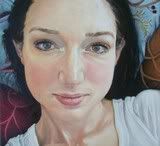How Picasso explained the afterlife to me:
Note: I have searched everywhere for the painting that I describe below, which was part of a traveling collection. I can't find it anywhere on the web. Maybe I have the name wrong, or maybe it's not catalogued. Picasso created over 22,000 works, including sketches, so I know it's out there somewhere. The Picasso pieces you see accompanying this post are: Joueur de Diaule Assis (1958) (below left) and Acrobat (1930) (below right). I was 21 and studying abroad in Paris when I learned that my grandmother—-my mother's mother—-was dying. I was actually standing in the basement of the Musee Picasso when I got the phone call. I turned around, completely shocked and numb, and ran smack into a work of Picasso's entitled Le Joueur du Football, or “The Soccer Player.” It must be obscure: it was a very small artwork, depicting the player as an amoeba-like form, and in fact the form was only recognizable as a human figure because Picasso gave it five extremities (head, arms and legs) and dressed it in a soccer uniform.
I was 21 and studying abroad in Paris when I learned that my grandmother—-my mother's mother—-was dying. I was actually standing in the basement of the Musee Picasso when I got the phone call. I turned around, completely shocked and numb, and ran smack into a work of Picasso's entitled Le Joueur du Football, or “The Soccer Player.” It must be obscure: it was a very small artwork, depicting the player as an amoeba-like form, and in fact the form was only recognizable as a human figure because Picasso gave it five extremities (head, arms and legs) and dressed it in a soccer uniform.
Maybe I was in denial, and wanted to concentrate on something other than my grandmother's death, but I stood in front of this picture for a long time. There wasn't anything in the picture that seemed typical of Picasso: it was a roughly sketched, preliminary piece of work, relegated to a little-traveled corner of the Museum's basement.
As I stood staring at the picture, it occurred to me that the blob-like form resembled a paper cut-out doll. I imagined taking scissors and cutting along the outline of the figure. And I thought: if I then curled the extremities of the paper figure inward, the shape would change from two dimensions into a three-dimensional sphere, a ball. The head, arms, and legs of the soccer player were like connected jigsaw puzzle pieces that fit almost perfectly together, with only a very little overlap in the finished spherical form.
And this made sense to me: a soccer player that transforms into the soccer ball. Picasso invented cubism, and here he had found another way to show the transformation from two to three dimensions.
Maybe God is an artist, and what we call death is really the experience of being cut out of this paper life by The Artist's hand. I'd never really thought about the meaning of an afterlife before.
Now I envisioned my grandmother transforming and entering an unimaginable new dimension of unity and wholeness, a place where the focus would no longer be on the individual but on the universal, a place where the puzzle finally made sense... I thought of my life as being no more than an illustration of the game we want to play, and the afterlife as being the real, the authentic, the genuine experience of this virtual reality. A week later, I came home, and I was with her when she died: I saw her entire face relax into a sweet tranquility. I know she's part of something amazing out there in the next world.
Tuesday, November 28, 2006
 Here's the link to my Channel 8 video (since I can't post it on this site): www.elisegres.com/bio/index.html
Here's the link to my Channel 8 video (since I can't post it on this site): www.elisegres.com/bio/index.html
It's on the right, in the column beneath the photo...
The reference to Duke law is incorrect: I went to Duke University for undergrad and then to University of Florida for my law degree. And I talk reeeaaaaallllly slowly in the clip: but hey, I used to stutter as a kid! We're lucky I can talk in complete sentences! :-)
Posted by
Elise Gres
at
3:41 PM
0
comments
![]()
Labels: tv
Tuesday, November 07, 2006
My interview with Gayle Guyardo aired on news channel 8 on Thursday, November 2, 2006, and I completely missed it! Fortunately, I am obtaining a copy from the station: I'll post the video as soon as I have the opportunity. What else? I still want to do the morning show with Ginger Gadsden, but think it would be best to wait several months and be able to display new artworks. I hope she'll still be interested!
Posted by
Elise Gres
at
1:57 PM
0
comments
![]()
Labels: tv
